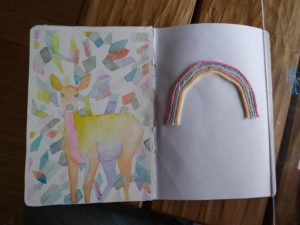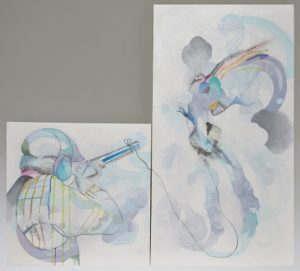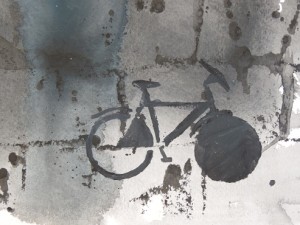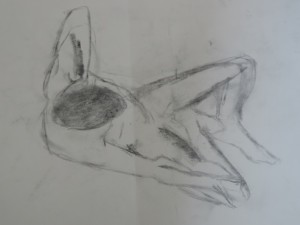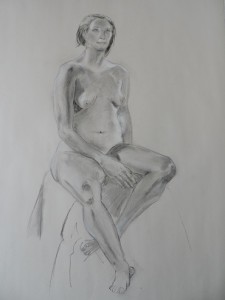The Sketchbook Project – Update
- At May 14, 2018
- By Amber
- In Studio Journal
 0
0
The Sketchbook Project
The sketchbook project is over : ( it is winging its way over to the Brooklyn Sketchbook Library. I can’t tell you how much I enjoyed participating in this project. Originally I decided that I would use the lyrics from a Jack Johnson guitar tab book to inspire the project but this turned out to be just the launch pad. Once I got more into the project I realised that there were things I wanted to try out so I went with it. I played with collage, gouache, abstract drawing and watercolour. There is even a pop up page. I had so much fun doing this; it has made me approach my sketch book in a whole new way. A little book of ideas and experimentation just for me. I have decided to keep this going and signed up to the 2018/2019 project!
The Animals in my Head
- At October 03, 2017
- By Amber
- In Studio Journal
 0
0
The Animals in my Head
“Once we were blobs in the sea, and then fishes, and then lizards and rats, and then monkeys, and hundreds of things in between. This hand was once a fin, this hand once had claws! In my human mouth I have the pointy teeth of a wolf and the chisel teeth of a rabbit and the grinding teeth of a cow! Our blood is as salty as the sea we used to live in! When we’re frightened, the hair on our skin stands up, just like it did when we had fur. We are history! Everything we’ve ever been on the way to becoming us, we still are.” (Terry Pratchett, A Hat Full of Sky)
The Saboteur is a painting from series I am working on called ‘The Animals in my Head”. I have been recording my dreams over recent years and I found that animals often make an appearance. The animal dreams stand out from the others, they are the ones that leave a lasting impression upon waking. In some instances I have dreamt about animals that I have only ever seen in books or on TV. It made me curious as to where this imagery could be coming from. I started to research dream imagery and quickly found Jung’s work on dreams and archetypal symbols.
Jung believes that we have in part inherited this symbolic language through our evolution. Archaic elements can occur in a dream, “mental forms whose presence cannot be explained by anything in the individual’s own life and which seem to be aboriginal, innate, and inherited shapes of the human mind” (Carl G. Jung, P57, Man and His Symbols 1964).
It is these archaic remnants of imagery from my uncivilized monkey mind that is the focus of this Series.
The Sketchbook Project
- At September 25, 2017
- By Amber
- In Studio Journal
 0
0
The Sketchbook Project
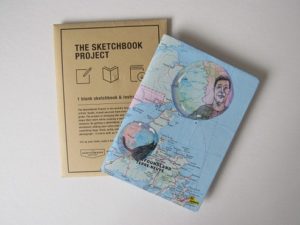 I have recently signed up to the Sketchbook Project. The goal is to fill a small sketchbook and submit it to the Brooklyn Art Library where it can be viewed by visitors or online. When I signed up to the project I really had no idea what theme I would use to fill the pages. I was browsing in Value Village and found a book of Jack Johnson sheet music for his album Bushfire Fairytales. Although I didn’t know his music I bought it, thinking that the pages of sheet music might be good for collage. I discovered the beautiful imagery in the lyrics and decided to make them the inspiration to fill my sketchbook. I am really enjoying thinking about and making the pages, it just feels like unadulterated play.
I have recently signed up to the Sketchbook Project. The goal is to fill a small sketchbook and submit it to the Brooklyn Art Library where it can be viewed by visitors or online. When I signed up to the project I really had no idea what theme I would use to fill the pages. I was browsing in Value Village and found a book of Jack Johnson sheet music for his album Bushfire Fairytales. Although I didn’t know his music I bought it, thinking that the pages of sheet music might be good for collage. I discovered the beautiful imagery in the lyrics and decided to make them the inspiration to fill my sketchbook. I am really enjoying thinking about and making the pages, it just feels like unadulterated play.
Fog Bank
- At October 22, 2016
- By Amber
- In Studio Journal
 1
1
Fog Bank
“For a moment he seemed impressed with the speaking loneliness of the scene, or rather with the complete abstraction from all its compass of the sights and sounds of man. Human shapes, interferences, troubles, and joys were all as if they were not, and there seemed to be on the shaded hemisphere of the globe no sentient being save himself; he could fancy them all gone round to the sunny side” Thomas Hardy – Far from the Madding Crowd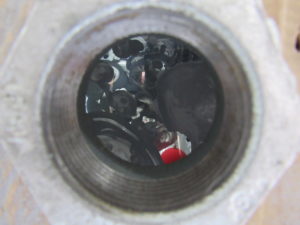
Fog Bank is a piece I have been working on over the last month. I submitted it for a call out titled “Boxed Sanctuary”. The exterior is made from reclaimed wood and the interior is a collection of miscellaneous objects and poured acrylic paint on clear sheets of plastic.
The call out asked the artist to address what sanctuary means to them. When I think of sanctuary, I think of the fog. It arrives in August and it is the antidote to the bright, bleaching, high contrast colours of summer. Colours become muted, they start to merge together; it is a soft blanket for my eyes. It dampens sound and comes with its own murmuring shush.
Fog Bank asks you to look inside, away from exterior distractions and cast yourself adrift in the shapes and colours that reside there.
The Proposal….a guide for proposal/submission writing
- At April 04, 2016
- By Amber
- In Studio Journal
 0
0
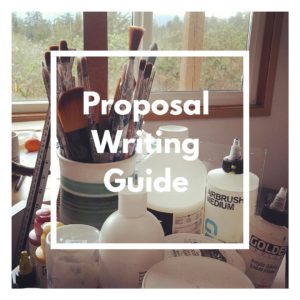 I recently went to a couple of free workshops, one by artist and author Nancy Crawford on putting together your portfolio and one by the good people of the Fifty Fifty Arts Collective, Open Space and the Ministry of Casual Living on Proposal Writing. Both covered putting together your Biography, CV, Artist’s Statement and portfolio images. A BIG thank you to both for providing these workshops, as someone who is largely self-taught they were so helpful in sorting out in my mind the purpose of all of the documentation that goes with your work when you make a submission.
I recently went to a couple of free workshops, one by artist and author Nancy Crawford on putting together your portfolio and one by the good people of the Fifty Fifty Arts Collective, Open Space and the Ministry of Casual Living on Proposal Writing. Both covered putting together your Biography, CV, Artist’s Statement and portfolio images. A BIG thank you to both for providing these workshops, as someone who is largely self-taught they were so helpful in sorting out in my mind the purpose of all of the documentation that goes with your work when you make a submission.
I thought that as I found it so helpful maybe others would too, here is summary of what I learnt….
CV
- Include education, relevant employment, curatorial projects, exhibitions, residencies, talks and panels, publications and reviews, awards, auctions, collections
- List exhibitions from most recent to older, include where, when and duration
- Programs – who did you work with? What did you get from the experience?
- Be clear and concise
- Keep formatting consistent
- No more than 3 pages
- Include your name and address on all pages
- Remember this is part of a package, do not duplicate information
- Indicate if shows are Group/ solo/ permanent / Juried
- List a couple of your references
- Your CV is not the space to get creative
Proposal
The proposal document is a layout of your proposed show, time line, media and logistics
- This is what I want to do.
- This is how I am going to do it.
- Explanation of your practise – why did you /or why are you going to make it?
- Tailor your proposal to the gallery space; let the curators know that you have considered the space, which pieces would you put where? Consider including a floor plan.
- Use direct language, be confident.
- Reference work in your portfolio to tie everything together in your submission package.
- Edit – do not include everything you have ever done, keep it relevant.
- Let the work speak for itself; don’t tell people how to read the work.
Artist Bio
- This is all about you – Where are you from? Who are you? What have you done?
- It is a profile, a brief CV.
- About 250 words
- Include photos of you, your studio space or yourself working.
Artist’s Statement
The Artist’s Statement is specific to the work in your proposal.
- You can be creative with this – use poetry and quotes
- Talk about your inspiration and evolutionary journey
- It should be about 3 paragraphs long.
- What is your medium/ dimensions etc.
- Why did you make it?
- What does it mean to you?
- This is to help the viewer understand your work but be careful not to over explain.
- Do not anticipate someone’s reaction to your work.
Portfolio Images
- Most proposals will specify their image requirements.
- If you are including photos of paintings do not include the frame or surrounding area. Crop the photo to exactly the size of the painting.
- Most submissions require the images to be 72 dpi max. This can be adjusted on Photoshop.
- Images should be in RBG color mode
- Use a common format like a jpeg
- A portfolio should consist of between 10 – 40 images of your strongest works.
- Include images that show details of a piece.
- Each Image should be labelled with the title, size, medium and year
It may be appropriate to include letters of recommendation – What is it like to work with you? Are you reliable? Include one letter that deals with you as an artist and one that deals with your character.
When you are submitting a proposal or application consider how you can make it easy for the administrator/adjudicator/curator to copy your submission and identify all parts of your package. If you are unsure about any part of the process don’t hesitate to contact the co-ordinator for clarification.
I hope this helps – I think I have some work to do on all my documentation!
Balance
- At November 21, 2015
- By Amber
- In Studio Journal
 0
0
I know I am not alone in my quest for balance between making art and having a paying job. Since moving to Canada in 2010 I have tried various set ups – seasonal work, temp jobs, random craigslist employment. None of these situations were ideal, usually because I let the paid work take over or they meant working weekends which meant no time with my family.
I was lucky enough to spend a year being supported by my husband which I have started to think of as the gap year I missed in my 20s. Whilst we can get by on his wage it made me feel uncomfortable not to be contributing to the household income. It didn’t seem fair to put all of the wage earning pressure on him. I weighed up my options. I considered if I could make a living just from selling my art – whilst I love the idea of that it just wasn’t realistic for me. I am just beginning and I really want to allow myself time to experiment and keep moving forward with the dreamscape ideas without worrying “will it sell?”. Lewis Hyde’s book ‘The Gift’ was particularly helpful in setting out reasons for separating your art making from market forces. I know that is a whole other debate.
In any event my full time work has come to an end and I have regular part time work now for 3 days per week at a job I enjoy, leaving the rest of my time for art and life. I am really happy with this arrangement – yes it will slow me down in the studio but I think it will be a good balance for me. Studio life can also be isolated, so being out in the world amongst people who don’t respond to every conversation with a meow might also not be a bad thing.
Talented
- At September 05, 2015
- By Amber
- In Studio Journal
 2
2
Talented…..
So I have started a blog, I am not sure how often I will update it but I wanted to write about the subject of talent. It isn’t often for me that the ideas in my head coagulate into writing.
I have started back at a life drawing group, there is no teacher so we sometimes ask each other for tips. A member of the group told me that she liked my drawing style and that I am talented. I admit it, this went to my head. She thinks I have talent? The rosy glow of her words lasted for an afternoon. The next day I went back to my drawing and realised it wasn’t that great “the hair is flat, some of the shading is clunky and it’s an easy posture”. I let the inner beast off the leash “you don’t have talent, you’re a fraud, an artist wannabe, how could you let that person think you are talented even for a second?” I will save the subject of the dangers of comparing and the inner beast for another time. I was thoroughly down on myself.
I decided to go back and look at the drawings I made when I started life drawing. I was shocked – some of them are really bad, I honestly didn’t remember them being that terrible. But as terrible as they are there is an obvious progression, at some point I discovered proportion, eventually some shaded muscles start to bulk out the form. Hands and feet remained the shape of spades and facial features are sparse. I was so pleased because I have come such a long way from those first sketches. This leads me back to talent, looking at my first drawings I don’t think anyone who saw them would have told me I have talent. So I ask, does talent exist at all? I love life drawing, for me it is a kind of meditation, when I am figure drawing there is nothing else, no brain static and 90% of the time I walk away a more content person. My love of it makes practising it a joy. I have been working on life drawing on and off over a period of years, I am still learning, seeing a progression in my work gives me hope that I will continue to grow and learn. I will take some of my first sketches with me to the next life drawing group to show my beginnings. Forget talent, if you love what you are doing, just keep going.

